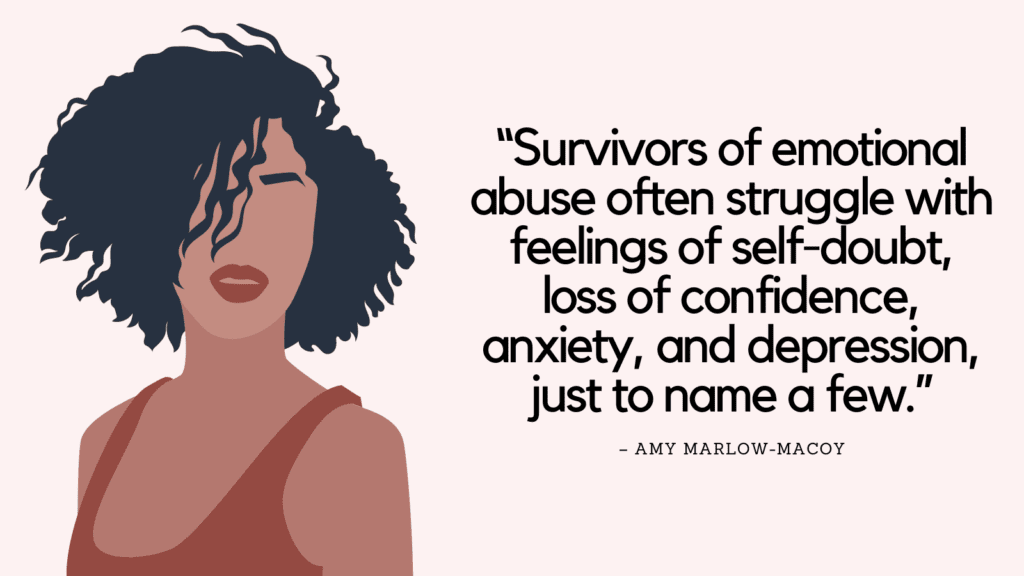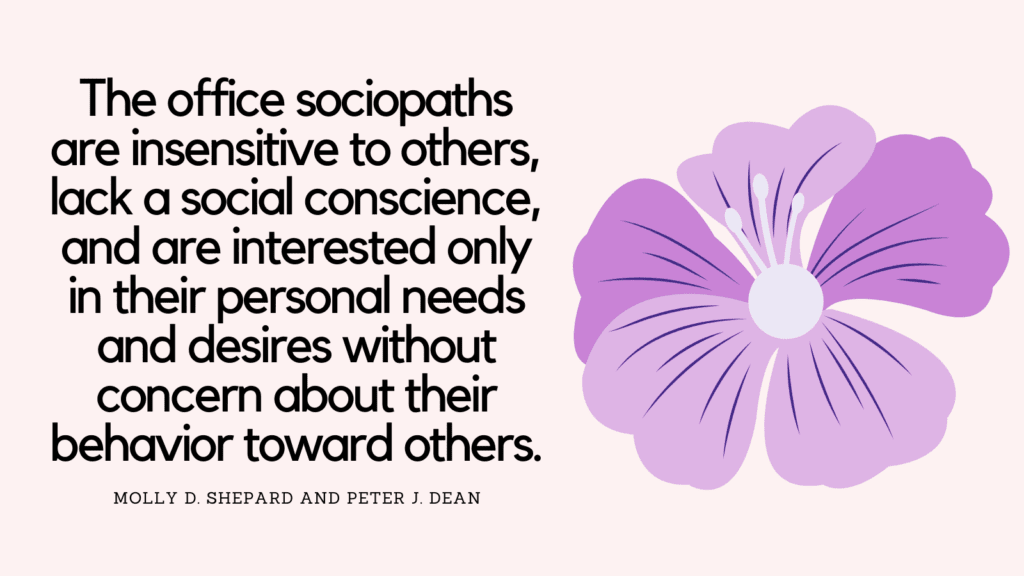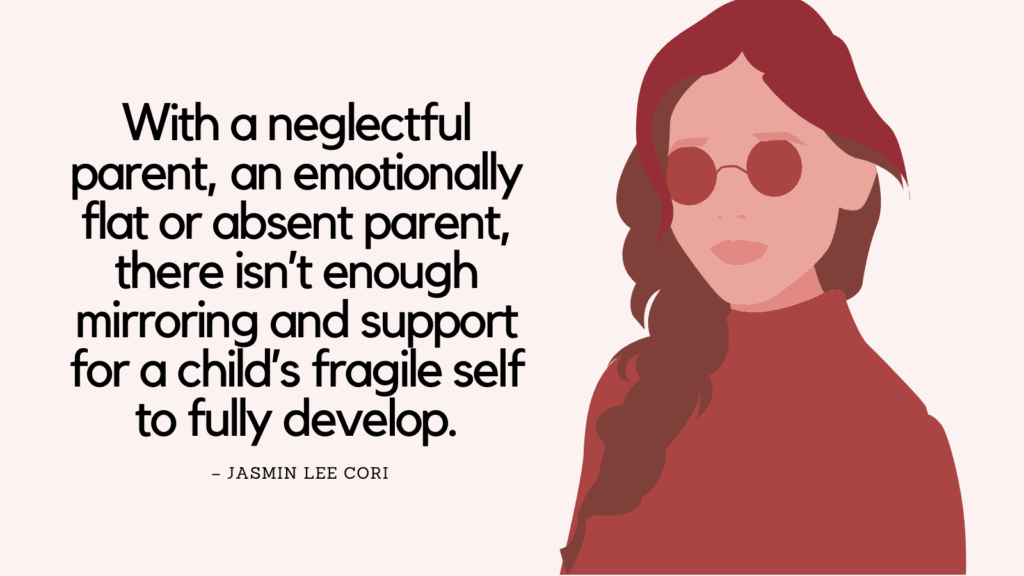This post contains some of the best mental and emotional abuse quotes.
What Is Mental and Emotional Abuse?
Mental and emotional abuse refers to patterns of harmful behavior that are directed towards an individual’s psychological and emotional well-being.
This type of abuse is characterized by the use of manipulative tactics, control, and power dynamics to exert dominance and undermine the victim’s self-esteem, autonomy, and sense of worth.
Mental and emotional abuse can take various forms, including but not limited to:
1. Verbal abuse: Persistent name-calling, insulting, belittling, or using derogatory language towards an individual.
2. Gaslighting: Manipulating someone into doubting their own perceptions, memories, and sanity, causing them to question their reality.
3. Threats and intimidation: Making threats of harm, either physical or emotional, in order to create fear and maintain control.
4. Isolation: Restricting an individual’s social interactions, isolating them from friends, family, and support networks
Mental And Emotional Abuse Quotes
1. “A threat is a statement of intent to cause you damage, pain, or loss. It is an act of coercion from an abuser, with an undercurrent of the potential for violence.” – Theresa Comito
2. “A vain person is preoccupied with their image, accomplishments, appearance, and qualities. An abusive partner may frequently tell their partner about all the abuser’s good qualities and actions, and how lucky the victim is to have them. The abuser may use that image to control the other person’s behavior, threatening to leave them if they make the abuser look bad.” – Theresa Comito
3. “Abuse thrives in silence and secrecy. Gaslighting can be an effective tool to silence someone by making them doubt their own credibility. Abusers will diminish the influence and reach of their victim’s voice through lying and discrediting. They may convince the victim that no one will believe them because they (the victim) are such an unreliable witness.” – Amy Marlow-MaCoy
4. “Abusers manipulate victims into abandoning their own reality, forcing them to accept the abuser’s version.” – Amy Marlow-MaCoy
Related: Healing From Emotional Abuse In 12 Practical Steps
5. “Abusers steamroll their victims because they feel entitled to change someone else’s reality rather than question their own.” – Amy Marlow-MaCoy
6. “Abusers who engage in gaslighting tactics often project onto you things that they have done, such as telling you that you’re confused, crazy, or intoxicated if you say what you know to be true or question their version of the facts.” – Theresa Comito
7. “An abusive person perceives your spending time with friends and family as a threat and can work to isolate you from them. They may begin this process by criticizing or devaluing your relationships with your friends and family.” – Theresa Comito
8. “Anyone can be abusive, but not everyone who abuses has a personality disorder” – Amy Marlow-MaCoy
Related: How To Break The Cycle Of Abuse? Top 10 Powerful Strategies To Stop Being An Abusive Person
9. “As a victim of emotional abuse, you may experience anxiety, depression, low self-esteem, confusion, difficulty concentrating or making decisions, and other physical symptoms.” – Theresa Comito
10. “Emotional abuse always accompanies physical or sexual abuse but stands fully on its own as damaging and destructive to an individual.” – Gregory L. Jantz
11. “Emotional abuse can exist in the form of “playful” teasing, sarcasm, or jokes. It is frequently verbally aggressive and threatening, but does not often begin that way.” – Theresa Comito
12. “Emotional abuse includes any nonphysical behavior—both overt and covert tactics—that occur as a pattern over time. These tactics include criticism (insults, name-calling, infantilization), hostility (yelling, silent treatment, verbal aggression), intimidation (posturing, threats), humiliation (using what they know about you to embarrass you), and harassment (persistent, repetitive demands).” – Theresa Comito
13. “Emotional abuse is a more pervasive form of abuse that, in most cases, precedes and accompanies physical and sexual abuse.” – Theresa Comito
14. “Emotional abuse is an intentional assault by one person on another to so distort the victim’s view of self that the victim allows the abuser to control him or her.” – Gregory L. Jantz
Related: Can Abusers Change? Top 17 Myths About Abusive Men That Make Women Stay With Abusers
15. “Emotional abuse is like the parable-pervasive, self-perpetuating, and so common that everyone can relate to it. In fact, that’s part of the problem: It is so common.” – Gregory L. Jantz
16. “Emotional abuse is more difficult to identify than physical abuse, although physical abuse is almost always accompanied by emotional abuse.” – Theresa Comito
17. “Emotional abuse is systematic, nonphysical bullying. It encompasses a pattern of behaviors used against the victim to hurt, undermine, and control them. The abuser’s primary mission is control.” – Theresa Comito
18. “Emotional abuse isn’t normal. Emotional abuse is the consistent pattern of being treated unfairly and unjustly over a period of time, usually by the same person or people. It can also be a onetime traumatic event that is left unresolved.” – Gregory L. Jantz
19. “Emotional and mental abuse are part of a larger overarching term—psychological violence. Psychological violence can be defined as behaviors and communication founded on control, disapproval, and domination.” – Theresa Comito
Related: Healing From Childhood Emotional Neglect In 6 Steps (+FREE Worksheets PDF)
20. “Emotional or psychological abuse can be a more effective means of control because it undermines the victim’s self-confidence and makes them question their own perceptions. It can destroy you from the inside out. It is the two-step alternation between loving and abusive behaviors that makes it so effective.” – Theresa Comito
21. “Gaslighting is a form of psychological and emotional abuse that causes victims to question their reality, judgment, self-perception, and, in extreme circumstances, their sanity.” – Amy Marlow-MaCoy
22. “Gaslighting is common in toxic romantic relationships as an effective way for abusers to control their partners.” – Amy Marlow-MaCoy
23. “Gaslighting separates you from your anchors in life: your sense of self and your ability to trust yourself. Losing the connection to your own sense of reality makes you vulnerable to further abuse and increases your dependence on the gaslighter and the distorted reality they put forth.” – Amy Marlow-MaCoy
24. “In situations of severe emotional abuse, gaslighting may provoke extreme stress in victims.” – Amy Marlow-MaCoy
25. “Isolation is a powerful and dangerous tool in the arsenal of an emotional abuser.” – Amy Marlow-MaCoy
Related: Childhood Emotional Neglect Test
26. “Jealousy is often discussed and justified by an abuser in terms of its relationship to love: “I am jealous because I love you so much.” Jealousy, however, has nothing to do with love. Instead, it indicates possessiveness, control, and a lack of trust. Jealous behaviors include questioning a partner’s whereabouts or intentions, and misreading facts to justify controlling behaviors.” – Theresa Comito
27. “Like a constant ringing in the ears or background noise, the frequency of emotional abuse has caused us to try to ignore it since we can’t ever seem to get away from it. And if we can ignore it, we can deny not only its existence but also its effects” – Gregory L. Jantz
28. “Like other forms of abuse, emotional abuse can be self-perpetuating, repeating the cycle throughout relationships and across generations. If emotional abuse occurs early in life, it can cause dysfunctional behavior into the adult years.” – Gregory L. Jantz
29. “Many people who are emotionally abused have difficulty falling asleep or staying asleep. Chronic stress and emotional abuse can lead to increased arousal—the body’s response to a chronic threat.” – Theresa Comito
30. “One key factor in determining whether a relationship is healthy or toxic is the presence or absence of emotional abuse and manipulation.” – Amy Marlow-MaCoy
31. “One reason gaslighting is so effective is that abusers convince their victims they are acting out of love or a sincere desire to help.” – Amy Marlow-MaCoy
Related: Emotionally Unavailable Parents Test (+FREE Worksheets)
32. “Ongoing emotional abuse wears us down and makes us much more likely to isolate ourselves from friends and family. This cuts us off from the opinions of others, and from the emotional support our friends and family provide. Our loved ones don’t have access to us and can’t notice the effects the abuse has on us.” – Theresa Comito
33. “Punishment is anything your abuser may do in response to any injury, refusal, or perceived rejection. Punishment can come in the form of revenge or conditioning. An abuser seeks revenge to inflict pain and conditions you in an attempt to change your behavior.” – Theresa Comito
34. “Since the abuse seemed so normal growing up, people will often attempt to recreate that normalcy in future relationships.” – Gregory L. Jantz
35. “Some abusers will project responsibility for their own feelings or actions onto their victims; when they accept this blame, victims feel overly responsible for things outside their control.” – Amy Marlow-MaCoy
36. “Survivors of emotional abuse often struggle with feelings of self-doubt, loss of confidence, anxiety, and depression, just to name a few.” – Amy Marlow-MaCoy
Related: Top 8 Dysfunctional Family Roles
37. “Targets of emotional abuse may find themselves vulnerable to guilt. An emotionally abusive partner may blame you for any problems they experience, including the abuse they inflict on you. The physical effects of guilt can include insomnia, a loss of appetite, sadness, and regret. Guilt can feel a lot like depression, and clinical depression can result from ongoing feelings of guilt and a false sense of responsibility to an abusive partner.” – Theresa Comito
38. “The abuser manipulates your thoughts and emotions by undermining your confidence, diminishing your self-esteem, and making you doubt your own judgment and sanity.” – Theresa Comito
39. “The abuser may be demanding and angry, or may offer more gentle “helpful suggestions.” They may embed criticism in these demands, or you may notice over time that when you don’t take their suggestions, there are consequences.” – Theresa Comito
40. “The abuser will not admit fault or take responsibility for their behavior. If they have difficulty at work or cannot hold a job, it is because they are treated unfairly. If they engage in abusive behavior toward someone else, it is the victim’s fault for making them angry.” – Theresa Comito
Related: Adult Child Syndrome: 3 Steps To Break Family Cycles
41. “The emotional abuser’s goal is to maintain control of their victim. The abuser wants the final word in every decision, to gain and maintain the upper hand.” – Theresa Comito
42. “The fear of what could happen to you becomes a powerful motivator for you to try to manage the relationship and accommodate the abuser.” – Theresa Comito
43. “The impact of emotional abuse on a person is just as damaging as the effects of physical abuse, and often even more so.” – Theresa Comito
44. “The invisible nature of emotional abuse, and a lack of understanding of precisely just what it is, makes this identification difficult.” – Theresa Comito
45. “The tragedy is that while sometimes these abusers are aware of what they are doing, often they are not. A habit of abuse has become a life pattern that is so comfortable, so normal for them, that they have stopped questioning the reasons behind their words and actions. As is so often the case in abuse, the abusers have a history of abuse in their own past and are acting out behavior that seems normal to them.” – Gregory L. Jantz
Related: Covert Verbal Abuse: What Is It & How To Recover From Verbal Abuse
46. “Victims may experience their partner/abuser as a “Dr. Jekyll and Mr. Hyde” type. The abuser’s dramatic mood swings and hypersensitivity often make victims feel confused and on edge. The abusive personality is fragile—easily insulted or offended, and often defensive.” – Theresa Comito
47. “We expect those closest to us to care for our well-being, and an expert gaslighter can make you believe he or she is hurting you for your own good.” – Amy Marlow-MaCoy
48. “We know there is a connection between abuse and trauma and chronic pain. While the reasons aren’t completely clear, it is believed that the chronic stress we experience in an abusive relationship causes overactivation of the fight-or-flight response.” – Theresa Comito
49. “While emotional abuse always accompanies physical and sexual abuse, it can also be present on its own. Because its implications have been overlooked, it has been left to do its damage in silence.” – Gregory L. Jantz
50. “While society has gone a long way toward making such outwardly aggressive behavior illegal, often it has turned a blind eye to the more subtle forms of oppression.” – Gregory L. Jantz
Related: Am I Being Verbally Abused Quiz
51. “Yelling is commonly known as the raising of someone’s voice, but abusers use yelling as a form of conditioning. The receiver is conditioned to be compliant with the yeller, who attempts to impose their will with this behavior. Yelling is a way of wearing down the victim and preventing their expression. Over time, it can whittle away a person’s spirit and dignity.” – Theresa Comito
52. “Control is both a tool and a goal for the abuser. The goal is to control every aspect of your life, because you are only there to meet the abuser’s needs. ” – Theresa Comito
53. “The abuser promotes their grandiose sense of self, boosting their sense of importance and superiority through controlling another. Insecurity, stress relief, and fear of abandonment are all possible reasons one person seeks to dominate another.” – Theresa Comito
54. “An abuser may remind you of past mistakes and failures, and then accuse you of being oversensitive and overreacting.” – Theresa Comito
55. “Healing from emotional abuse is possible. The first steps in your recovery will include identifying what happened to you, understanding that it is not your fault, and recognizing that nothing you did caused your abuser to act this way.” – Theresa Comito
Related: Emotional Abuse In Relationships Quiz

How to Heal from Mental and Emotional Abuse?
Healing from mental and emotional abuse can be a complex and challenging process. Here are some suggestions that may help in your healing journey:
1. Validate your emotions: Understand that your feelings are valid and acknowledge the impact of the abuse on your mental and emotional well-being.
2. Establish boundaries: Identify and set clear boundaries to protect yourself from further harm. This may involve limiting or cutting off contact with the abuser if necessary.
3. Seek support: Reach out to trusted friends, family members, or support groups who can provide empathy, validation, and understanding. Consider consulting with a licensed therapist or counselor experienced in trauma and abuse.
4. Practice self-care: Engage in activities that promote self-care, such as mindfulness, exercise, journaling, creative outlets, or engaging in hobbies that bring you joy and relaxation. Prioritize taking care of your physical, emotional, and mental well-being.
5. Challenge negative beliefs: Recognize and challenge any negative beliefs or distorted thoughts that may have resulted from the abuse. Use the following questioning technique:
- Is there evidence to support this thought? What are the facts?
- What alternative explanations or interpretations are possible?
- What would I say to a friend who has a similar thought? Would I view it as realistic or distorted?
- How accurate or fair are my thoughts about myself, others, or the world?
- What would be a more balanced or helpful way to think about this situation?
- 6. Process your emotions: Allow yourself to grieve and process your emotions related to the abuse. This may involve journaling, talking about your experiences, or expressing yourself in a safe and supportive environment.
7. Educate yourself: Learn about the dynamics of abuse, trauma, and their effects on mental health. Understanding the psychological aspects can empower you and provide insights into your healing process.
8. Develop healthy coping mechanisms: Explore healthy coping strategies, such as deep breathing exercises, meditation, grounding techniques, or engaging in therapeutic activities like art therapy or cognitive-behavioral coping skills.
Conclusion
Healing is a personal and unique journey. It takes time, patience, and self-compassion. Surround yourself with compassionate and supportive individuals who can help you through this process.



